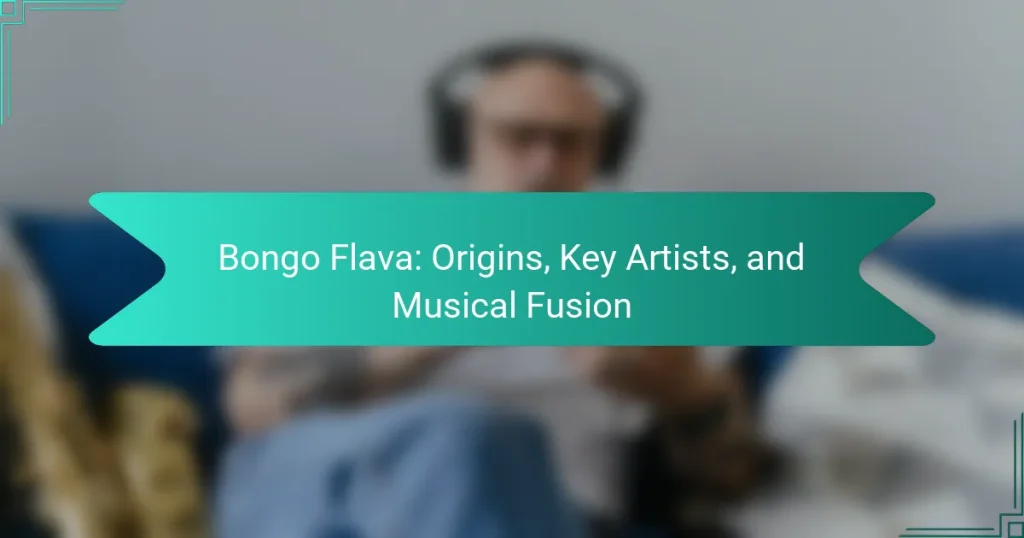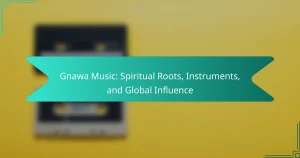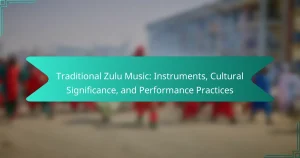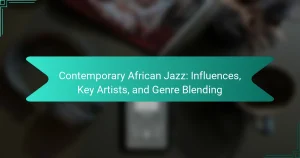Bongo Flava is a Tanzanian music genre that fuses hip-hop, R&B, and traditional Tanzanian styles, with its name derived from Dar es Salaam, the capital city. Emerging in the late 1990s, Bongo Flava gained popularity in the 2000s, thanks to artists like Juma Nature and Lady Jaydee who helped popularize the genre through Swahili lyrics that address local culture and social issues. The genre has significantly influenced the East African music scene and continues to evolve, reflecting contemporary trends and challenges. Bongo Flava also plays a vital role in shaping Tanzanian culture, impacting music, fashion, and social discourse, while events like the Tanzania Music Awards promote local talent within this vibrant musical landscape.
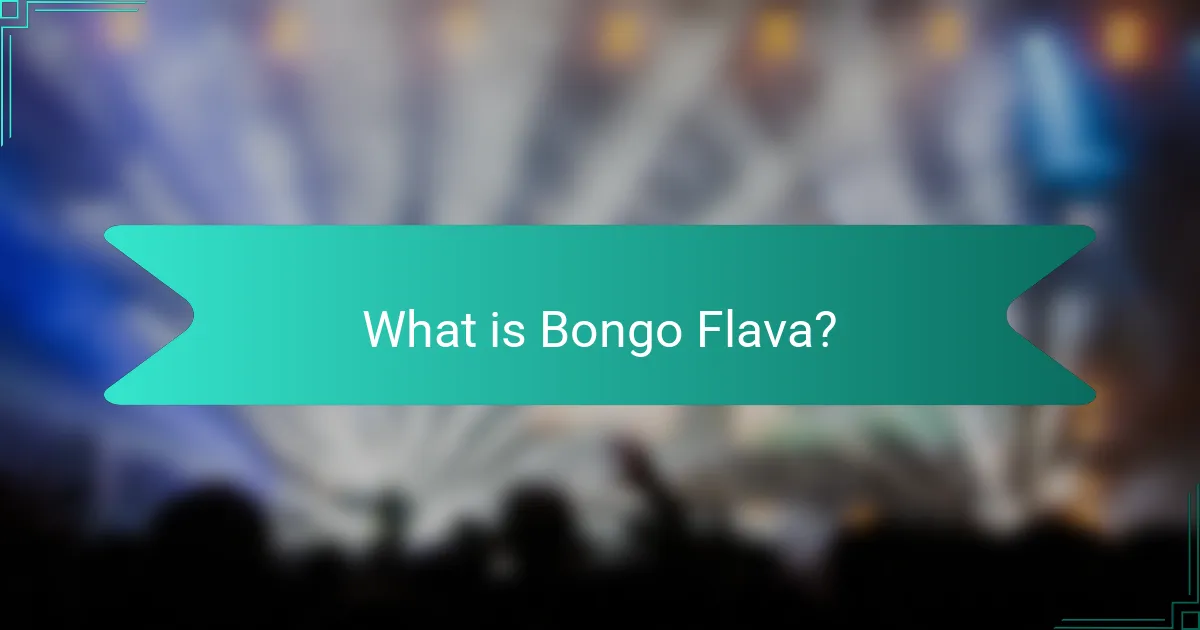
What is Bongo Flava?
Bongo Flava is a genre of music that originated in Tanzania. It blends hip-hop, R&B, and traditional Tanzanian music styles. The term ‘Bongo’ refers to Dar es Salaam, the capital city. Flava signifies the unique flavor of this musical style. The genre emerged in the late 1990s and gained popularity in the 2000s. Artists often sing in Swahili, reflecting local culture and issues. Bongo Flava has influenced the East African music scene significantly. It showcases a fusion of global and local sounds, making it distinct.
How did Bongo Flava originate?
Bongo Flava originated in the 1990s in Tanzania. It emerged as a fusion of hip-hop, R&B, and traditional Tanzanian music. The genre began gaining popularity among urban youth in Dar es Salaam. Artists incorporated local languages, primarily Swahili, into their lyrics. The rise of Bongo Flava was influenced by the globalization of music and the accessibility of recording technology. Key figures like Professor Jay and Juma Nature helped shape its sound. The genre reflects social issues and cultural identity in Tanzania. By the early 2000s, Bongo Flava had gained international recognition.
What cultural influences shaped the beginnings of Bongo Flava?
Bongo Flava originated from a blend of various cultural influences in Tanzania. The genre combines traditional Tanzanian music, hip-hop, reggae, and R&B. Influences from local genres like taarab and ngoma are evident in its sound. The rise of urbanization in the 1990s played a significant role in its development. Young artists began expressing their experiences through music in urban settings. The use of Swahili lyrics made Bongo Flava relatable to the local audience. Additionally, the globalization of music brought international styles into the mix. This fusion created a unique sound that defines Bongo Flava today.
How did socio-political factors contribute to its development?
Socio-political factors significantly influenced the development of Bongo Flava. The genre emerged in Tanzania during the late 1990s. Political changes, including the introduction of multiparty democracy, allowed for greater freedom of expression. This led artists to address social issues through their music. Economic challenges also played a role, as many artists reflected the struggles of urban youth. The rise of hip-hop culture globally inspired local musicians to create a unique sound. Additionally, the influence of Tanzanian Swahili culture shaped lyrical content and themes. Overall, these socio-political dynamics fostered an environment where Bongo Flava could thrive and evolve.
What are the key characteristics of Bongo Flava music?
Bongo Flava music is a genre originating from Tanzania that blends hip-hop, R&B, and traditional African sounds. It often features Swahili lyrics, reflecting local culture and social issues. The genre is characterized by its catchy melodies and rhythmic beats, making it popular in East Africa. Bongo Flava artists frequently use digital production techniques, which enhances its modern appeal. The music often includes collaborations with various artists, showcasing a fusion of different musical styles. Themes in Bongo Flava songs often address love, social justice, and everyday life experiences in Tanzania. The genre has gained international recognition, contributing to the global music scene.
What musical genres influence Bongo Flava?
Bongo Flava is influenced by several musical genres. Key influences include hip hop, R&B, reggae, and traditional Tanzanian music. Hip hop provides the rhythmic and lyrical style prevalent in Bongo Flava. R&B contributes melodic elements and emotional depth to the genre. Reggae adds a laid-back groove and social commentary themes. Traditional Tanzanian music infuses local cultural elements and rhythms. These genres blend to create a unique sound that characterizes Bongo Flava. The fusion reflects Tanzania’s diverse musical landscape and cultural heritage.
How does the lyrical content of Bongo Flava reflect its roots?
The lyrical content of Bongo Flava reflects its roots by incorporating themes of daily life, social issues, and cultural identity. Artists often address local challenges such as poverty, love, and resilience. The use of Swahili language connects the music to Tanzanian heritage. Bongo Flava lyrics also draw from traditional storytelling methods, blending modern and historical narratives. This fusion highlights the genre’s African influences, particularly from hip-hop and reggae. Many songs reflect the socio-political landscape of Tanzania, resonating with the experiences of the youth. Overall, the lyrics serve as a voice for the community, emphasizing both struggles and aspirations.
Who are the most prominent artists in Bongo Flava?
The most prominent artists in Bongo Flava include Diamond Platnumz, Ali Kiba, and Vanessa Mdee. Diamond Platnumz is known for his international hits and influence in the genre. He has won multiple awards, including the International African Music Awards. Ali Kiba is recognized for his melodic style and has a strong fan base across East Africa. Vanessa Mdee is celebrated for her unique voice and contributions to female representation in the genre. Other notable artists include Nandy and Harmonize, both of whom have gained significant popularity and acclaim in recent years.
What roles do artists like Diamond Platnumz and Ali Kiba play in popularizing Bongo Flava?
Artists like Diamond Platnumz and Ali Kiba play significant roles in popularizing Bongo Flava. They are influential figures in the Tanzanian music scene. Diamond Platnumz is known for his catchy melodies and high-energy performances. His songs often blend traditional Tanzanian sounds with contemporary genres. Ali Kiba contributes with his unique vocal style and lyrical depth. Both artists have large followings on social media platforms. Their collaborations with international artists increase Bongo Flava’s global reach. They have also won multiple awards, showcasing their impact on the genre. Overall, their contributions help elevate Bongo Flava’s status in the African music landscape.
How have collaborations impacted the growth of Bongo Flava artists?
Collaborations have significantly boosted the growth of Bongo Flava artists. These partnerships expand their audience reach and enhance their musical diversity. By working with artists from different genres, Bongo Flava musicians incorporate various styles and sounds. This fusion attracts listeners from diverse backgrounds. Notable collaborations, such as those between Bongo Flava artists and international stars, have led to increased visibility. For instance, collaborations with artists like Diamond Platnumz and international acts have garnered millions of views on platforms like YouTube. Such exposure often translates into higher streaming numbers and concert attendance. Overall, collaborations serve as a catalyst for artistic innovation and commercial success in the Bongo Flava genre.
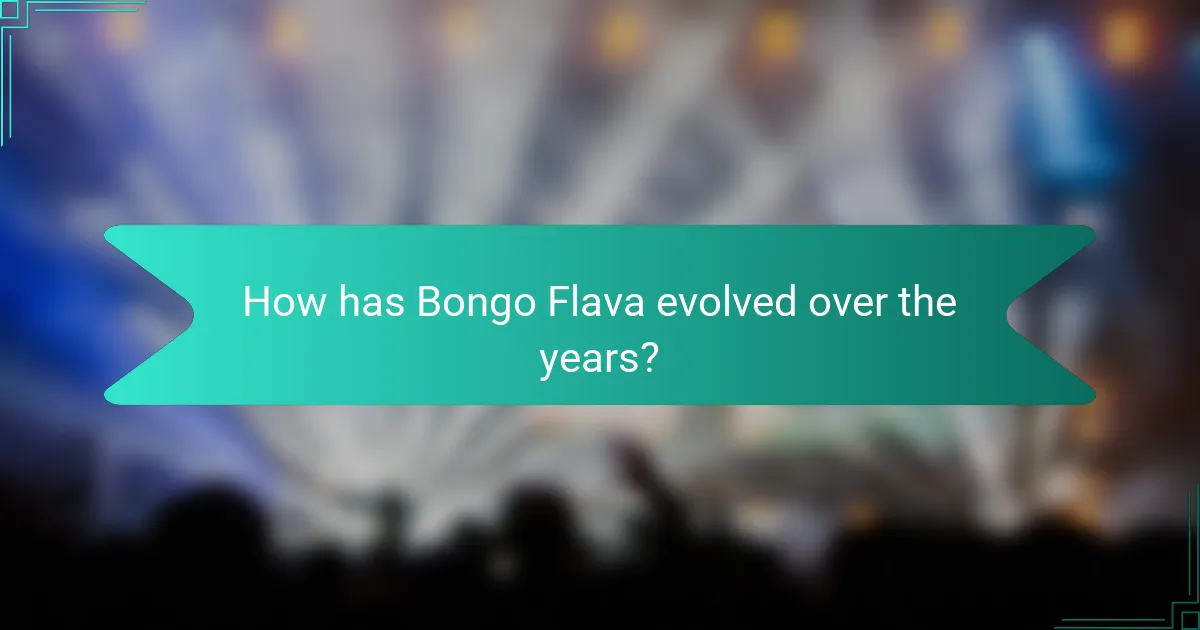
How has Bongo Flava evolved over the years?
Bongo Flava has evolved significantly since its inception in the 1990s. Initially, it emerged as a blend of hip-hop, R&B, and traditional Tanzanian music. Over the years, it incorporated influences from various genres, including reggae and dancehall. The use of Swahili lyrics became a defining characteristic, making it accessible to a wider audience. Key artists like Juma Nature and Lady Jaydee played pivotal roles in popularizing the genre. By the 2000s, Bongo Flava gained international recognition, with artists collaborating with global musicians. The rise of digital platforms further propelled its growth, allowing for broader distribution and audience engagement. Today, Bongo Flava continues to evolve, reflecting contemporary social issues and trends in its lyrics and production styles.
What are the significant milestones in Bongo Flava’s history?
Bongo Flava’s history features several significant milestones. The genre emerged in the late 1990s in Tanzania. It combined hip-hop, R&B, and traditional Tanzanian music. In 2000, the first Bongo Flava album was released by artist Juma Nature. This marked the genre’s official entry into the music industry. By 2003, Bongo Flava gained popularity across East Africa. Artists like Diamond Platnumz and Ali Kiba rose to prominence. In 2010, the genre expanded internationally, reaching audiences beyond Africa. The introduction of digital platforms further propelled Bongo Flava’s global reach.
How did the rise of digital platforms influence Bongo Flava’s reach?
The rise of digital platforms significantly expanded Bongo Flava’s reach. Artists gained access to global audiences through streaming services and social media. Platforms like YouTube and Spotify allowed for easy distribution of music. This accessibility led to increased visibility for Bongo Flava artists. Statistics show that music consumption in Tanzania grew by over 30% with digital access. Social media facilitated direct interaction between artists and fans, enhancing engagement. Consequently, Bongo Flava became a key player in the East African music scene. The genre’s fusion of local and international styles attracted diverse listeners.
What role do music festivals play in promoting Bongo Flava today?
Music festivals play a significant role in promoting Bongo Flava today. They provide a platform for artists to showcase their music to large audiences. Festivals often feature a mix of established and emerging Bongo Flava artists. This exposure helps to elevate the genre’s visibility both locally and internationally. Additionally, festivals create opportunities for collaboration among artists. They foster a sense of community among fans and musicians. The vibrant atmosphere of festivals enhances the cultural appreciation of Bongo Flava. Overall, music festivals are crucial in sustaining and expanding the reach of Bongo Flava.
What are the current trends in Bongo Flava music?
Current trends in Bongo Flava music include the fusion of traditional and contemporary sounds. Artists are increasingly incorporating elements from genres like hip-hop, R&B, and Afrobeat. Collaborations between Bongo Flava artists and international musicians are on the rise. This cross-genre collaboration expands the audience and enhances creativity. Additionally, the use of digital platforms for music distribution is growing. Streaming services are becoming primary channels for reaching fans. Social media plays a crucial role in promoting new releases and engaging with listeners. Emerging artists are gaining popularity through viral challenges and trends on platforms like TikTok. These trends reflect the evolving nature of Bongo Flava and its adaptability to global music influences.
How is Bongo Flava blending with other musical styles?
Bongo Flava is blending with other musical styles through collaborations and genre fusions. Artists incorporate elements of hip-hop, R&B, and dancehall into their music. This blending creates a unique sound that appeals to diverse audiences. For example, Bongo Flava artists often use hip-hop beats while maintaining traditional Tanzanian melodies. Collaborations with international artists further enhance this musical fusion. Notable examples include tracks featuring reggae and afrobeat influences. The integration of different styles allows Bongo Flava to evolve continuously. This dynamic approach keeps the genre relevant in the global music scene.
What innovations are artists introducing to keep Bongo Flava relevant?
Artists are introducing collaborations with international musicians to keep Bongo Flava relevant. This strategy expands the genre’s reach and diversifies its sound. Additionally, artists are incorporating modern production techniques, such as electronic beats and sampling. These innovations attract younger audiences and keep the music contemporary. Visual storytelling through music videos is also being emphasized. High-quality visuals enhance the artistic expression and engage fans. Furthermore, social media platforms are utilized for promotion and interaction. This direct engagement helps build a loyal fan base. These combined efforts ensure Bongo Flava remains dynamic and appealing in the evolving music landscape.
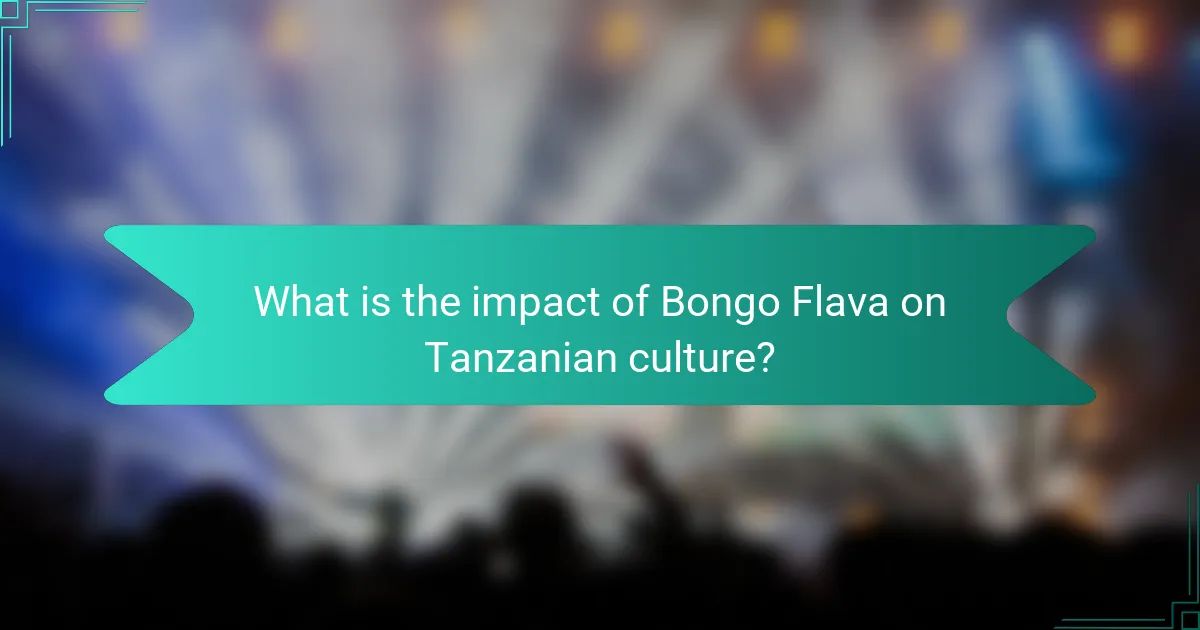
What is the impact of Bongo Flava on Tanzanian culture?
Bongo Flava significantly impacts Tanzanian culture by shaping its music, fashion, and social discourse. This genre blends traditional Tanzanian sounds with hip-hop and R&B influences. It serves as a voice for youth, expressing their aspirations and challenges. Bongo Flava artists often address social issues, including poverty and education, through their lyrics. The genre has popularized Swahili in contemporary music, enhancing its cultural significance. Events like the Tanzania Music Awards celebrate Bongo Flava, promoting local talent. The rise of Bongo Flava has also influenced fashion trends among Tanzanian youth, reflecting modern urban styles. Overall, Bongo Flava plays a crucial role in the cultural identity and social dynamics of Tanzania.
How does Bongo Flava reflect social issues in Tanzania?
Bongo Flava reflects social issues in Tanzania by addressing topics such as poverty, corruption, and love. The genre often highlights the struggles faced by everyday Tanzanians. Artists use their lyrics to critique government policies and social injustices. For example, songs discuss the impact of economic hardships on families. Bongo Flava also sheds light on health issues, including HIV/AIDS awareness. The music resonates with youth, providing a voice for their experiences. This connection makes Bongo Flava a powerful tool for social commentary.
What messages are conveyed through Bongo Flava lyrics?
Bongo Flava lyrics convey messages of social issues, love, and personal experiences. These lyrics often address challenges faced by Tanzanian youth. Common themes include poverty, corruption, and the quest for a better life. Love and relationships are also prominent, exploring both romantic and familial connections. Artists use storytelling to reflect their realities and aspirations. The genre serves as a voice for marginalized communities. Additionally, Bongo Flava promotes cultural identity and pride. It often incorporates local languages and slang, making it relatable to the audience.
How is Bongo Flava perceived by different generations in Tanzania?
Bongo Flava is perceived differently across generations in Tanzania. Younger generations embrace Bongo Flava as a vibrant expression of contemporary culture. They appreciate its fusion of hip-hop, R&B, and traditional Tanzanian sounds. This demographic often engages with Bongo Flava through social media and music streaming platforms.
In contrast, older generations may view Bongo Flava with skepticism. They often prefer traditional Tanzanian music and may see Bongo Flava as a departure from cultural roots. Some older individuals criticize its lyrical content and commercialization.
Despite these differing perceptions, Bongo Flava has gained significant popularity across all age groups. It has become a defining genre in Tanzania’s music scene. The genre reflects societal changes and the evolution of Tanzanian identity.
What role does Bongo Flava play in the global music scene?
Bongo Flava plays a significant role in the global music scene by promoting Tanzanian culture and contemporary African sounds. It blends various genres, including hip-hop, R&B, and traditional Tanzanian music. This genre has gained international recognition, especially among African diaspora communities. Key artists like Diamond Platnumz and Vanessa Mdee have contributed to its global reach. Bongo Flava’s lyrics often address social issues, resonating with a broad audience. The genre’s popularity has led to collaborations with international artists, further enhancing its visibility. Bongo Flava also influences music trends in other African countries, showcasing its impact on the continent’s music landscape.
How have international collaborations influenced Bongo Flava’s exposure?
International collaborations have significantly enhanced Bongo Flava’s exposure. Collaborations with global artists introduce the genre to wider audiences. This cross-cultural exchange fosters greater appreciation for Bongo Flava. Notable partnerships with artists like Akon and P-Square have elevated its profile internationally. These collaborations often result in music videos with millions of views on platforms like YouTube. Increased streaming on global music platforms also contributes to its popularity. Furthermore, international tours featuring Bongo Flava artists help promote the genre abroad. Such exposure ultimately leads to a more diverse fan base and increased opportunities for local artists.
What are the challenges Bongo Flava faces in gaining global recognition?
Bongo Flava faces several challenges in gaining global recognition. Limited international exposure restricts its reach beyond East Africa. Language barriers hinder non-Swahili speakers from fully appreciating the music. Additionally, competition with established global genres makes it difficult to stand out. Lack of marketing resources affects artists’ ability to promote their work internationally. Furthermore, insufficient support from local music industries limits access to global platforms. These factors collectively impede Bongo Flava’s growth on the world stage.
What are some practical ways to explore Bongo Flava music?
Listen to popular Bongo Flava artists on streaming platforms. Notable artists include Diamond Platnumz and Ali Kiba. Attend live performances or music festivals featuring Bongo Flava. Explore music videos on platforms like YouTube for visual and cultural context. Join online communities or forums dedicated to Bongo Flava music. Read articles and blogs that analyze its history and influence. Follow Bongo Flava playlists curated by music experts on platforms like Spotify. Purchase albums or merchandise from Bongo Flava artists to support the genre directly.
What playlists or albums should newcomers listen to for a comprehensive understanding of Bongo Flava?
Newcomers should listen to the album “Dar es Salaam” by Juma Nature for a comprehensive understanding of Bongo Flava. This album showcases the genre’s roots and contemporary sound. Another essential album is “Kiboko Changu” by Professor Jay. It features a blend of hip-hop and traditional Tanzanian music. The playlist “Bongo Flava Essentials” on streaming platforms includes various hits from key artists. These selections highlight the evolution and influence of Bongo Flava. Listening to these albums and playlists provides insight into the genre’s cultural significance and musical diversity.
How can fans engage with Bongo Flava artists and the community?
Fans can engage with Bongo Flava artists and the community through social media platforms. Artists often share updates, music releases, and personal insights on platforms like Instagram and Twitter. Fans can comment, share, and participate in discussions about the music. Attending live performances is another way for fans to connect. Concerts and festivals provide opportunities for direct interaction. Collaborations between artists and fans often occur during these events. Additionally, fans can support artists by purchasing their music and merchandise. Engaging with community initiatives and local events also fosters connections within the Bongo Flava scene. These interactions strengthen the relationship between artists and their audience.
Bongo Flava is a Tanzanian music genre that combines hip-hop, R&B, and traditional Tanzanian sounds, emerging in the late 1990s. The article explores its origins, cultural influences, and socio-political factors that shaped its development. Key artists such as Diamond Platnumz and Ali Kiba are highlighted for their roles in popularizing the genre, while collaborations and digital platforms are discussed as significant contributors to its growth and global reach. Additionally, the article examines how Bongo Flava reflects social issues in Tanzania and its impact on the country’s cultural identity.
